2017 MERCEDES-BENZ E43AMG ECU
[x] Cancel search: ECUPage 69 of 482

With HANDS-FREE ACCESS you can open, close
or inter rupt trunk lid mo vement byper form ing a
kicking mo vement under there ar bumper.
The kicking mo vement triggers the opening or
closing process alternately.
Obser vethe no tes when opening (
→page 63)
and closing (→page 64)th e trunk lid.
% Awa rning tone sounds while the trunk lid is
opening or closing.
& WARNING Risk of burn s causedbya hot
ex haust sy stem
The vehicle exhaust sy stem can become very
hot. If you use HANDS- FREEACCES S,you
could burn yourself by touching theex haust
sy stem.
#Alw ays ensure that you only ma kea
kicking mo vement within the de tection
ra nge of the sensors.
* NO
TEDama getotheve hicle caused by
unin tentional lyopening the trunk lid
RWhen using an automatic car wash
RWhen using a high pressure cleaner
#Deactivate KEYLESS-GO or make sure
that the SmartK eylocated is at least
10 ft(3 m) away from theve hicle in
such situations.
When making the kicking mo vement, make sure
th at you are standing firm ly on the ground, oth‐
erwise you could lose your balance, e.g. on ice.
Re quirements:
RThe SmartK eyis behind theve hicle.
RStand at least 12in (30 cm) away from the
ve hicle while per form ing the kicking mo ve‐
ment.
RDo not come into contact with the bumper
while making the kicking mo vement.
RDo not car ryout the kicking mo vement too
slowl y.
RThe kicking mo vement must be towa rdsth e
ve hicle and bac k.
1Sensor detection range
If se veral consecutive kicking mo vements are
not successful, waitte n seconds.
Sy stem limitations
The sy stem may be impaired or may not function
if:
RThe area around the sensor is dirty, e.g. due
to road salt or snow .
RThe kicking movement is made using a pros‐
th etic leg.
Opening and closing 67
Page 98 of 482
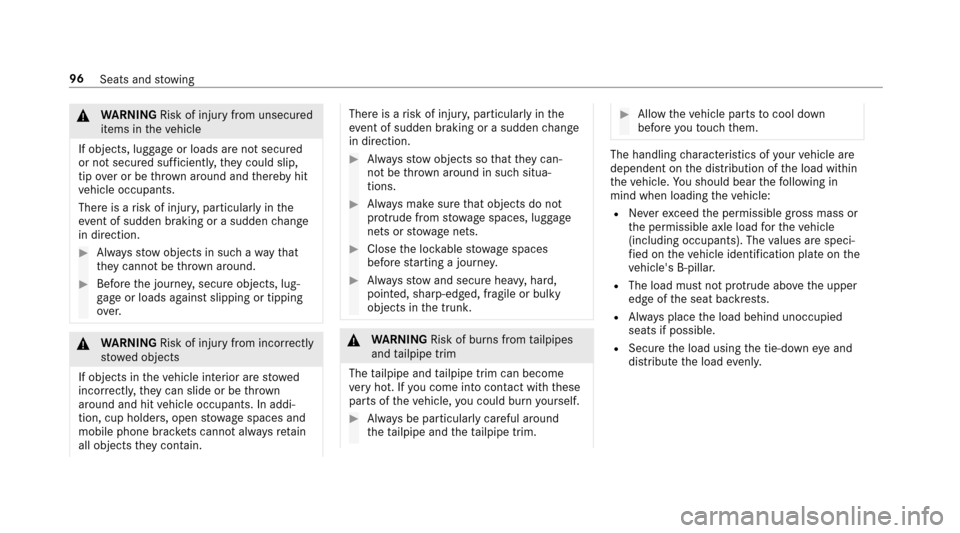
&WARNING Risk of injury from unsecured
items in theve hicle
If objects, luggage or loads are not secured
or not secured suf ficientl y,they could slip,
tip ove r or be throw n around and thereby hit
ve hicle occupants.
There is a risk of injur y,particularly in the
ev ent of sudden braking or a sudden change
in direction.
#Alw aysstow objects in such a wayth at
th ey cannot be thro wn around.
#Before the journe y,secure objects, lug‐
ga ge or loads against slipping or tipping
ove r.
&
WARNING Risk of injury from incorrectly
stowe d objects
If objects in theve hicle interior are stowed
incor rectly, they can slide or be throw n
around and hit vehicle occupants. In addi‐
tion, cup holders, open stowage spaces and
mobile phone brac kets cann otalw aysre tain
all objects they contain.
There is arisk of injur y,particularly in the
ev ent of sudden braking or a sudden change
in direction.
#Alw aysstow objects so that they can‐
not be throw n around in such situa‐
tions.
#Alw ays make sure that objects do not
pr otru de from stowage spaces, luggage
nets or stowage nets.
#Close the loc kable stow age spaces
before starting a journe y.
#Alwaysstow and secure heavy, hard,
pointe d, sharp-edged, fragile or bulky
objects in the trunk.
&
WARNING Risk of burn s fromtailpipes
and tailpipe trim
The tailpipe and tailpipe trim can become
ve ry hot. If you come into contact withth ese
parts of theve hicle, you could burn yourself.
#Alw ays be particular lycareful around
th eta ilpipe and theta ilpipe trim.
#Allow theve hicle parts tocool down
before youto uch them.
The handling characteristics of your vehicle are
dependent on the distribution of the load within
th eve hicle. You should bear thefo llowing in
mind when loading theve hicle:
RNe verex ceed the permissible gross mass or
th e permissible axle load forth eve hicle
(including occupants). The values are speci‐
fi ed on theve hicle identification plate on the
ve hicle's B-pillar.
RThe load must not pr otru de abo vethe upper
edge of the seat backrests.
RAlw ays place the load behind unoccupied
seats if possible.
RSecure the load using the tie-down eye and
distribute the load evenly.
96
Seats and stowing
Page 102 of 482
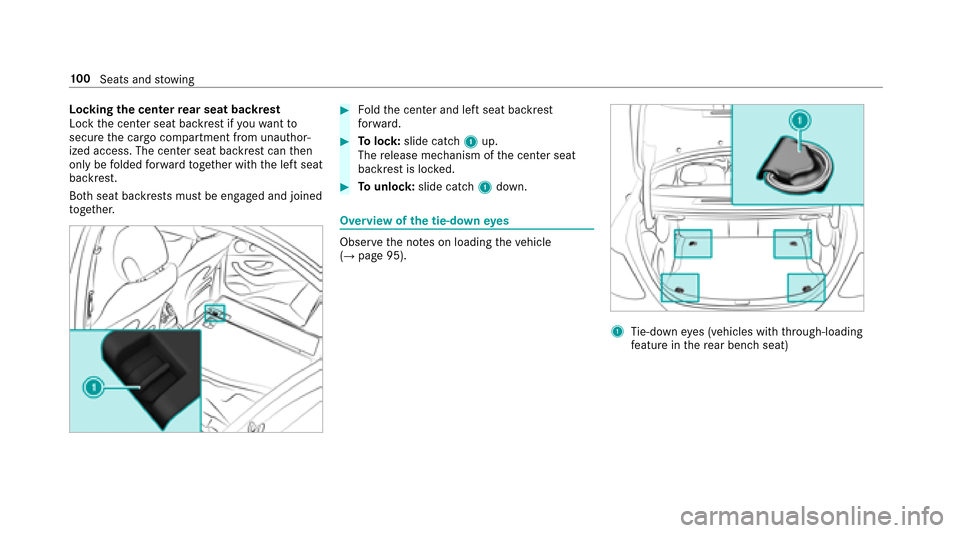
Lockingthe center rear seat backrest
Lock the center seat backrest if youwa ntto
secure the cargo compartment from unauthor‐
ized access. The center seat backrest can then
only be folded forw ard toget her with the left seat
backrest.
Bo th seat backrests must be engaged and joined
to ge ther.#Fo ldthe center and left seat backrest
fo rw ard.
#To lock: slide catch 1up.
The release mechanism of the center seat
backrest is loc ked.
#To unlock :slide catch 1down.
Overview ofthe tie-down eyes
Obser vethe no tes on loading theve hicle
(→page 95).
1Ti e-down eyes (vehicles with thro ugh-loading
fe ature in there ar bench seat)
100
Seats and stowing
Page 103 of 482
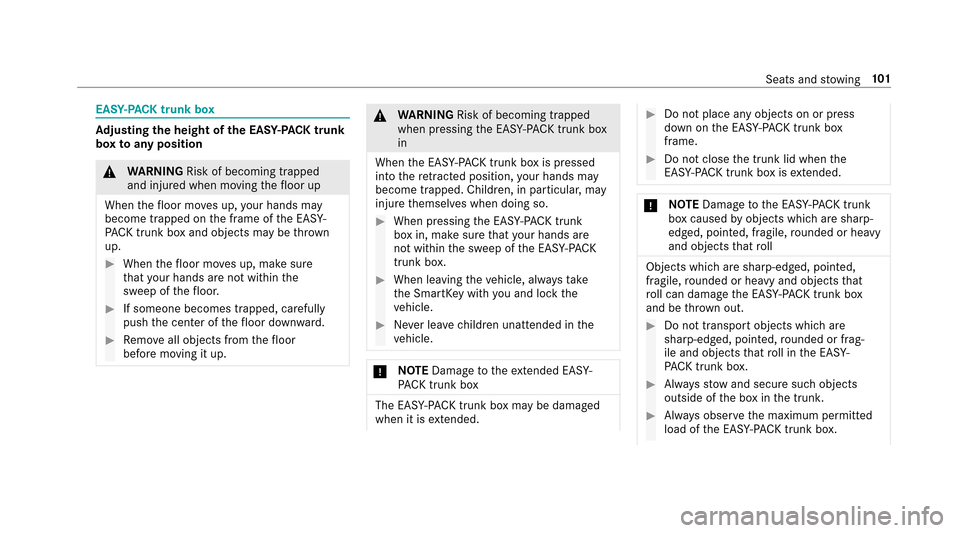
EASY-PA CK trunk box
Adjusting the height of the EA SY-PAC K trunk
box toany position
&
WARNING Risk of becoming trapped
and injure d when moving thefloor up
When thefloor mo ves up, your hands may
become trapped on the frame of the EA SY-
PA CK trun kbo xan dobject sma ybe throw n
up.
#When thefloor mo ves up, make sure
th at your hands are notwithin the
sweep of thefloor.
#If someone becomes trapped, carefully
push the center of thefloor down ward.
#Re mo veall objects from thefloor
before moving it up.
& WARNING Risk of becoming trapped
when pressing the EA SY-PAC K trunk box
in
When the EA SY-PACK tr unkbox is pressed
into there tracted position, your hands may
become trapped. Children, in particular, may
injure themselves when doing so.
#When pressing the EA SY-PAC K trunk
box in, make sure that your hands are
not within the sweep of the EA SY-PACK
tr unk box.
#When leaving theve hicle, alw aysta ke
th e SmartK eywith you and lock the
ve hicle.
#Ne ver lea vechildren unatte nded inthe
ve hicle.
* NO
TEDama getotheex tended EAS Y-
PA CK tr unk box
The EA SY-PAC K trunk box may be damage d
when it is extended.
#Do not place any objects on or press
down on the EA SY-PAC K trunk box
frame.
#Do not close the trunk lid when the
EAS Y-PA CK tr unk box is extended.
* NO
TEDama getothe EA SY-PAC K trunk
box caused byobjects which are sharp-
edged, pointed, fragile, rounded or heavy
and objects that roll
Objects which are sharp-edged, pointed,
fragile, rounded or heavy and objects that
ro ll can damage the EA SY-PAC K trunk box
and be thro wn out.
#Do not transport objects which are
sharp-edged, pointe d,rounded or frag‐
ile and objects that roll in the EA SY-
PA CK tr unk box.
#Alwaysstow and secure such objects
outside of the box in the trunk.
#Alw ays obser vethe maximum permitted
load of the EA SY-PAC K trunk box.
Seats and stowing 10
1
Page 106 of 482

Attachin gth ero of rack
&
WARNING Risk of injury by exceeding
th e maximum roof load
When you load thero of, theve hicle center of
gr av ity rises and the driving characteristics
ch ange.
If yo uexc eed the maximum roof load, the
driving characteristics, as well as thesteer‐
ing and braking, will be greatly impaired.
#Ne verexc eed the maximum roof load
and adjust your dr ivingst yle.
Yo uwill find information on the maximum roof
load in the "Technical data" section.
Re quirements
ROnly use roof rack ste sted and appr ovedby
Mercedes-Benz.
RMake sure that you can raise the sliding sun‐
ro of fully and open the trunk lid fully once
th ero of rack is ins talled.
RThe panoramic sliding sunroof cannot be
opened if a roof rack is ins talled. The panor‐ amic sliding sunroof closes again automati‐
cally when it encounters
resis tance.
* NO
TEDama getothe co vers
The co vers may be dama ged and scratched
when being opened.
#Do not use me tallic or hard objects.
#Fo ld co vers 1 carefully up wards in the
direction of the ar row.
#Only secure thero of rack tothe anchorage
points under co vers 1.
#Alw ays comply with thero of rack manufac‐
turer's ins tallation instructions.
#Secure the load on thero of rack .
Cup holder
Installing or removing the cup holder in the
center console
& WARNING ‑ Risk of accident or injury
when using the cup holder while the
ve hicle is moving
The cup holder cannot secure containers
while theve hicle is moving.
If yo u use a cup holder while theve hicle is
moving, the conta iner may be flung around
and liq uidsmay be spilled. The vehicle occu‐
pants may come into contact with the liquid
and if it is hot, they could be scalded. You
10 4
Seats and stowing
Page 111 of 482
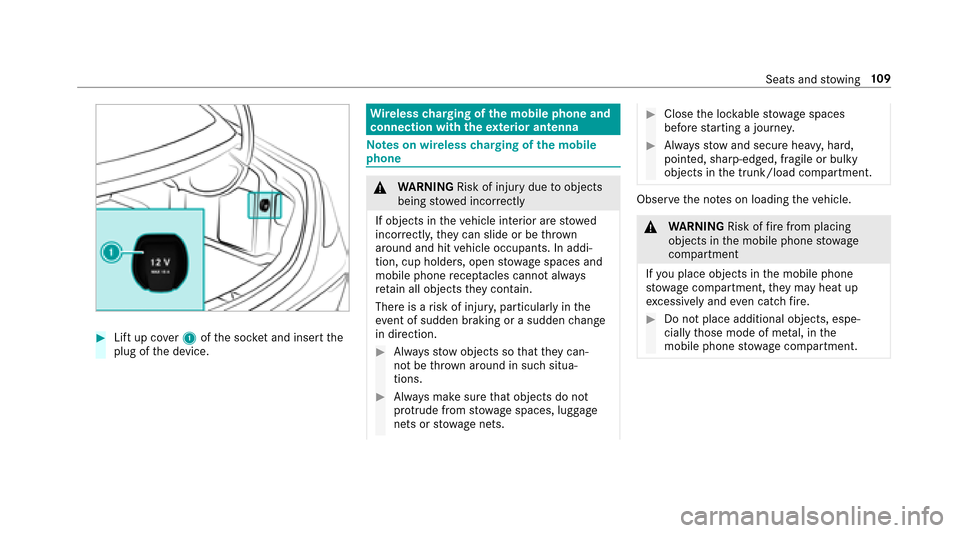
#Lift up cover1 ofthe soc ket and insert the
plug of the device.
Wire lesscharging of the mobile phone and
connection with theex terior antenna
Note s on wireless charging of the mobile
phone
& WARNING Risk of injury duetoobjects
being stowed incor rectly
If objects in theve hicle interior are stowed
incor rectly, they can slide or be throw n
around and hit vehicle occupants. In addi‐
tion, cup holders, open stowage spaces and
mobile phone recep tacles cannot al ways
re tain all objects they contain.
There is arisk of injur y,particularly in the
ev ent of sudden braking or a sudden change
in direction.
#Alw aysstow objects so that they can‐
not be throw n around in such situa‐
tions.
#Alw ays make sure that objects do not
pr otru de from stowage spaces, luggage
nets or stowage nets.
#Close the loc kable stow age spaces
before starting a journe y.
#Alwaysstow and secure heavy, hard,
pointe d, sharp-edged, fragile or bulky
objects in the trunk/load compartment.
Obser vethe no tes on loading theve hicle.
&
WARNING Risk offire from placing
objects in the mobile phone stowage
compartment
If yo u place objects in the mobile phone
stow age compartment, they may heat up
exc essively and even catch fire .
#Do not place additional objects, espe‐
cially those mode of me tal, in the
mobile phone stowage compartment.
Seats and stowing 10
9
Page 113 of 482
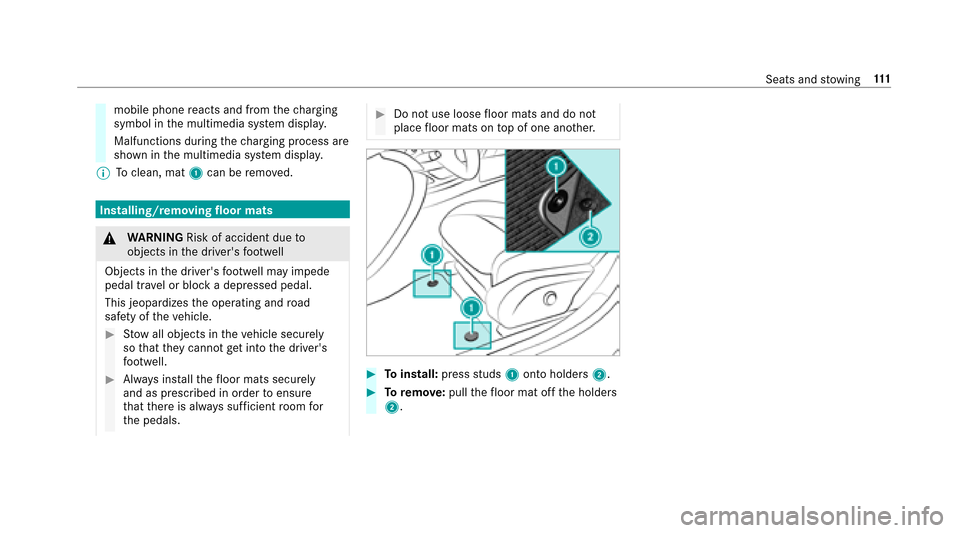
mobile phonereacts and from thech arging
symbol in the multimedia sy stem displa y.
Malfunctions during thech arging process are
shown in the multimedia sy stem displa y.
% Toclean, mat 1can be remo ved.
Installing/removing floor mats
&
WARNING Risk of accident due to
objects in the driver's foot we ll
Objects in the driver's foot we ll may impede
pedal tr avel or block a depressed pedal.
This jeopardizes the operating and road
saf etyof theve hicle.
#Stow all objects in theve hicle securely
so that they cannot getinto the driver's
fo ot we ll.
#Alw ays ins tallth efloor mats securely
and as prescribed in order toensure
th at there is alw ays suf ficient room for
th e pedals.
#Do not use loose floor mats and do not
place floor mats on top of one ano ther.
#To install: pressstuds 1onto holders 2.
#Toremo ve:pull thefloor mat off the holders
2.
Seats and stowing 111
Page 133 of 482

#Always secure the engine against unin‐
te ntional starting before car rying out
maintenance or repair work.
Re quirementsRPark position jis selected.
RThe anti- theft alarm sy stem is not armed.
RThe panic alarm is not armed.
RThe hazard warning lights are switched off.
RThe engine hood is closed.
RThe doors are closed and loc ked.
RThe windo wsand sliding sunro of are closed.
#Start theve hicle using the smartphone:RAf tereve ryvehicle start, the engine runs for
te n minu tes.
RYo u can car ryout a maximum of two consec‐
utive starting attem pts.
RYo u can stop theve hicle again at any time.
RFu rther information can be found inthe
smartphone app. Securing
the engine against starting before
car rying out maintenance or repair work:
#Switch on the hazard warning lights.
or
#Un lock the doors.
or
#Open a side window or the sliding sunroof.
St arting theve hicle in emer gency operation
mode
If th eve hicle cannot be star ted, the�3�O�D�F�H �W�K�H
�.�H�\ �L�Q �W�K�H �0�D�U�N�H�G �6�S�D�F�H �6�H�H �2�S�H�U�D�W�R�U�
�V �0�D�Q�X�D�O
display message appears in the multifunction
displa y.
#Make sure that mar ked space 2is em pty.
#Re mo veSmartK ey1 from theke yring.
#Place Smart Key1 in mar ked space 2.
The vehicle will start af ter a short while.
If yo ure mo veSmartK ey1 from mar ked
space 2the engine continues running. For
fur ther vehicle starts ho wever,SmartK ey1
must be located in mar ked space 2during
th e entire journe y.
#Have SmartK ey1 checked at a qualified
specialist workshop.
If th eve hicle does not star t:
#Lea veSmartK ey1 in mar ked space 2.
#Depress the brake pedal and start theve hicle
using thest art/ stop button.
% You can also switchon the po wer supp lyor
th e ignition with thest art/ stop button.
Driving and parking 13
1